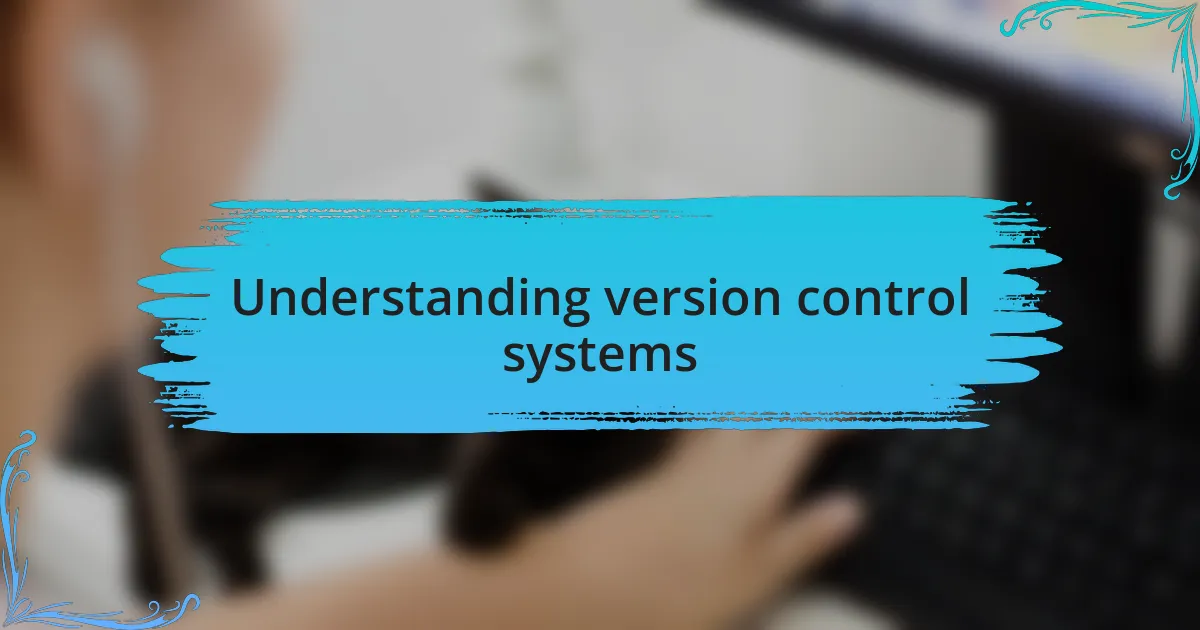Key takeaways:
- Version control systems enhance collaboration by allowing developers to manage code changes without fear of overwriting others’ work.
- Regularly committing changes and using clear, descriptive commit messages improves project management and debugging efficiency.
- Adopting structured branching strategies, like Git Flow, simplifies workflow and enhances teamwork.
- Embracing a “fail fast, learn fast” mindset fosters a culture of continuous improvement and collaboration.

Understanding version control systems
When I first encountered version control systems, I was struck by how they can fundamentally change the way developers manage their projects. It’s not just about tracking code changes; it’s about cultivating a collaborative environment where everyone can contribute without the fear of overwriting someone else’s work. Isn’t it reassuring to know that with just a few commands, you can go back to earlier versions of your project if something goes wrong?
The way version control systems operate can sometimes feel overwhelming, especially with concepts like branching and merging. However, once I started to grasp these ideas, I realized they were key to managing complex projects. Branching allows developers to explore new features without disrupting the main code base. Have you ever wished you could try out an idea without the risk? That’s exactly what branching offers.
For me, version control systems have become essential tools that bring order to what can feel like chaos. They provide a structured way to handle changes over time, making it easier to collaborate with others. Every time I see a colleague pushing their code confidently, I’m reminded of how empowering these systems are. It’s like having a safety net; you can take risks and innovate with the knowledge that your past work is preserved.

Best practices in version control
When managing version control, I’ve found that committing changes frequently is one of the best practices. I remember a project where I waited too long to commit, and when bugs arose, tracing back through countless lines of code felt like searching for a needle in a haystack. Does that sound familiar? By committing often, I not only keep a clean history but also mitigate the stress of debugging.
Using clear and descriptive commit messages has always been a priority for me. I’ve learned that a message like “Fixed bug in user authentication” can be incredibly helpful during a sprint review, while a vague “stuff fixed” does nothing for anyone. Wouldn’t you agree that clarity in communication is essential for collaboration? This simple practice enhances the entire team’s understanding and keeps everyone on the same page.
Branching strategies are another area where I’ve seen significant benefits. Over the years, I’ve adopted the Git Flow model, which separates features, hotfixes, and releases. It’s been a game-changer for my workflow. I vividly recall launching a major feature and feeling reassured knowing I had a stable main branch to return to if issues arose. Isn’t it comforting to have that level of organization? Embracing a structured approach to branching not only simplifies project management but also enhances teamwork.

Lessons learned from version control
Lessons learned from version control
One key lesson I’ve taken away from my experience with version control is the importance of regularly reviewing your commit history. Early on, I neglected this practice, and it led to confusion when trying to remember the rationale behind certain decisions. Can you imagine going back to a project after months and finding it difficult to piece together why you did something? Now, I make it a habit to glance through commit history before starting a new sprint; it keeps me grounded and aligns my focus with the project’s objectives.
Another insight I gained is the value of pairing version control with code reviews. In one instance, I collaborated on a project where pull requests sparked conversations that revealed underlying issues I hadn’t considered. Have you ever opened a pull request and suddenly found yourself discussing architecture choices and potential pitfalls? Those discussions not only improved the quality of the code but also deepened the team’s understanding of the project as a whole.
Lastly, I’ve learned the art of accepting mistakes without fear. In the past, I was overly cautious, avoiding commits that I thought might not be perfect. I remember the day a teammate encouraged me to embrace the “fail fast, learn fast” mindset, and it was liberating. Isn’t it fascinating how freeing it can be to let go of perfectionism? This shift allowed me to contribute more openly and collaborate more effectively, ultimately fostering a culture of continuous improvement among my peers.